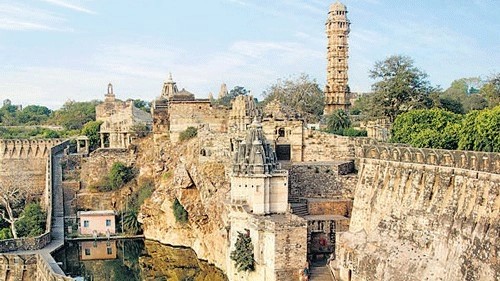
The 1,000-year-old Chittorgarh fort is said to have been affected by mining.
Credit: DH Photo
New Delhi: The Supreme Court has prohibited the mining of limestone by blasting or use of explosives within a radius of five kilometres from compound wall of Rajasthan's iconic Chittorgarh Fort, constructed in the Mauryan period and declared as a heritage monument.
A bench of Justices Sanjiv Khanna and S V Bhatti did not agree to a report by court commissioned CSIR-CBRI, Roorkee suggesting safe minimum distance for blasting operations from the Chittorgarh Fort and instead directed for a fresh study.
The court noted the exploitation of minerals available in the surrounding area by the lessees to the state government, particularly in an unscientific manner or disproportionate exploitation of minerals in hardcore mining activities, was a threat to the existential utility of the Chittorgarh Fort and the structures.
"The issue is undoubtedly of grave concern, and the conflict between the exploitation of mineral wealth and sustaining the neighbourhood, stated pithily, adheres to the principle of sustainable exploitation of mineral resources without adversely affecting the community interest in any manner," the bench added.
The court noted the CSIR-CBRI, Roorkee's September 30, 2014 report was not in line with the Report of the Ministry of Coal and Mines, Indian Bureau of Mines, Mining Research Cell.
It directed the Chairman, Indian Institute of Technology (Indian School of Mines), Dhanbad, Jharkhand to constitute a team of multi-disciplinary experts in civil engineering, earthquake engineering, structural geology and mining engineering, within two weeks to undertake within four months the study of environmental pollution and impact on all the structures in the Chittorgarh Fort from the blasting operations beyond a five-kilometre radius.
"We declare and hold that notwithstanding any liberal recommendation on undertaking blasting operations nearer to the Chittorgarh Fort, keeping in perspective the continuous exposure of ancient monuments to peak particle velocity (PPV) arising from blasting, a radius of five kilometres from the compound wall of the Fort shall not be subjected to mining by blasting or use of explosives for mining of any minerals," the bench ordered.
Holding that the approach to preserving the monument must be multidimensional, the bench said with the passage of every year, the need to preserve monuments has increased.
"The prohibition and regulation of blasting would address only one front of the problems identified in the report. Therefore, this court is of the firm view that the Chittorgarh Fort, a heritage monument, must be maintained and preserved under all the circumstances," the bench said.
It also directed the Union government through the Director General, ASI, to file a compliance report on the deficiencies noted in the monument’s maintenance, steps initiated and progress made by the next date of hearing.
The court noticed other contributory circumstances viz negligence causing deterioration to the structures in Chittorgarh Fort. "Monkey menace, human/tourist footfall, unwanted vegetation growth, and the defacing of statues are a few factors recorded in the report dated 30.09.2014 that are contributing to the deterioration of the Fort. The extent of damage to the monument is a serious question. So, the prevention of damage from any such collateral activities must be simultaneously addressed by the State Government of Rajasthan and the ASI," the court ordered.
It directed the Rajasthan government to implement Solid Waste Management Rules and to take all steps necessary to control the monkey menace and the sources of unauthorised littering in the entire Fort and the neighbourhood.
Hearing a plea by Birla Corporation Limited against the HC's ban on use of blasting operations, the bench said the common thread running through the argument of the counsel was that the steps needed to preserve the Fort are implemented and if need be, the court could issue continuous mandamus (a judicial writ issued as a command) from time to time to the authorities.
"This court at this stage of consideration ought not to accept the electronic blasting system technique suggested by the petitioner can be a safe solution to allow mining operations by blasting without a prohibitory radius. By choice, we prefer a third-party institution and experts in this branch of engineering/science to undertake the study independently and file a report before this court on these aspects," the bench said.
The court posted the matter for further consideration on July 9, 2024.
